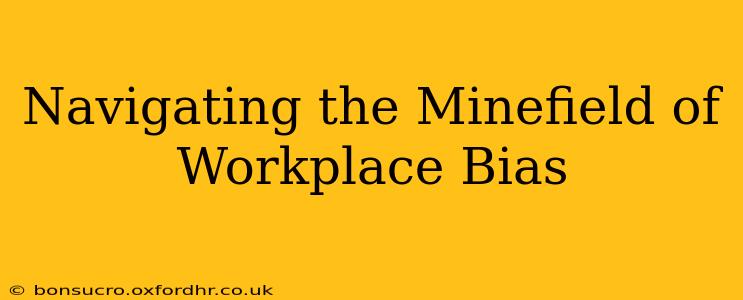Workplace bias, a pervasive issue impacting productivity, morale, and overall success, manifests in various insidious forms. Understanding its nuances is crucial for fostering a truly inclusive and equitable work environment. This article delves into the complexities of workplace bias, exploring its different types, the detrimental effects it has, and crucially, strategies for effective mitigation and prevention. We'll address common questions surrounding this critical topic, equipping you with the knowledge to navigate this challenging landscape.
What are the different types of workplace bias?
Workplace bias isn't a monolithic entity; it encompasses a wide spectrum of prejudices, both conscious and unconscious. Some key types include:
-
Confirmation bias: This involves favoring information that confirms pre-existing beliefs and dismissing contradictory evidence. In the workplace, this might lead to overlooking a qualified candidate from an underrepresented group because their qualifications don't align with a preconceived notion of what a "successful" employee looks like.
-
Affinity bias: This is the tendency to favor individuals we perceive as similar to ourselves – whether it’s based on shared background, interests, or even just a feeling of rapport. While seemingly harmless, this can unintentionally exclude talented individuals who are different.
-
Halo effect: This involves letting one positive trait overshadow other aspects of a person's performance or character. For instance, a charismatic employee might be forgiven for consistently missing deadlines, while a quieter, equally competent employee might not receive the same leniency.
-
Horn effect: This is the opposite of the halo effect – one negative trait disproportionately influences the overall perception of an individual, overshadowing their positive attributes.
-
Gender bias: This is a pervasive form of bias that often manifests in unequal pay, promotion opportunities, and job assignments based solely on gender.
-
Racial bias: This involves discrimination based on race or ethnicity, leading to unfair treatment in hiring, promotion, performance evaluations, and disciplinary actions.
-
Age bias: This form of bias often targets younger or older employees, leading to stereotypes about their capabilities, experience, or adaptability.
-
Implicit bias: This is perhaps the most insidious type of bias as it operates subconsciously. It's the unconscious attitudes or stereotypes that affect our understanding, actions, and decisions. It's crucial to acknowledge that even individuals committed to fairness can hold implicit biases.
How does workplace bias impact productivity and morale?
The consequences of unchecked workplace bias are far-reaching. It directly impacts:
-
Productivity: A biased environment fosters distrust and resentment, leading to decreased motivation, reduced engagement, and ultimately, lower productivity. Employees who feel undervalued or discriminated against are less likely to contribute their best work.
-
Morale: A lack of inclusivity and fairness creates a toxic work environment, severely impacting employee morale and job satisfaction. High turnover rates and difficulty attracting top talent are common consequences.
-
Innovation and creativity: Diverse perspectives are essential for innovation. A workplace that excludes or marginalizes certain groups stifles creativity and prevents the organization from reaching its full potential.
-
Company reputation: News of workplace bias can severely damage a company's reputation, impacting its brand image and attracting negative media attention. This can have a significant impact on attracting investors and clients.
How can I identify and address bias in my workplace?
Recognizing and addressing bias requires proactive measures at both individual and organizational levels. This includes:
-
Self-reflection: Individuals should actively examine their own biases and strive to understand how their actions and decisions might inadvertently perpetuate inequality.
-
Diversity and inclusion training: Comprehensive training programs can raise awareness about different types of bias and provide practical strategies for mitigating their impact.
-
Blind recruitment processes: Removing identifying information from resumes during the initial screening stages can help minimize unconscious bias in hiring decisions.
-
Data-driven performance evaluations: Implementing objective performance metrics and regular feedback mechanisms can reduce the influence of personal biases in performance assessments.
-
Mentorship and sponsorship programs: Providing opportunities for underrepresented groups to receive guidance and support from senior leaders can help foster their career development.
-
Establishing clear policies and procedures: A strong anti-discrimination policy with clear procedures for reporting and addressing bias is crucial. This policy must be enforced consistently.
-
Promote open communication and feedback mechanisms: Create a culture where employees feel comfortable reporting instances of bias without fear of retaliation.
What are some strategies for preventing workplace bias?
Prevention is key. Instituting long-term strategies focused on diversity and inclusion helps minimize the risk of bias:
-
Cultivating a culture of inclusivity: Promoting a culture where everyone feels valued, respected, and heard is paramount. This includes fostering open communication, active listening, and empathy.
-
Diverse hiring practices: Actively recruiting candidates from diverse backgrounds ensures a more representative workforce. This might involve partnering with organizations focused on diversity recruitment.
-
Ongoing training and education: Regular training on unconscious bias, diversity, and inclusion keeps the topic at the forefront and allows for ongoing learning and development.
-
Accountability: Holding individuals and teams accountable for their actions and decisions contributes to a more equitable environment.
How can companies create a more inclusive work environment?
Creating a truly inclusive workplace requires a multi-pronged approach involving:
-
Leadership commitment: Senior leaders must actively champion diversity and inclusion, setting the tone and expectation from the top down.
-
Employee resource groups (ERGs): Supporting and encouraging ERGs allows employees from underrepresented groups to connect, network, and advocate for their needs.
-
Regular diversity audits: Periodic audits of hiring, promotion, and compensation data can reveal potential disparities and inform targeted interventions.
-
Measuring and tracking progress: Setting specific, measurable goals for diversity and inclusion and tracking progress towards these goals is crucial for accountability and continuous improvement.
By acknowledging the complexity of workplace bias and implementing proactive strategies, organizations can create a more equitable, inclusive, and ultimately, more successful work environment for everyone. The journey toward eliminating bias is continuous, but with commitment and consistent effort, it is achievable.
